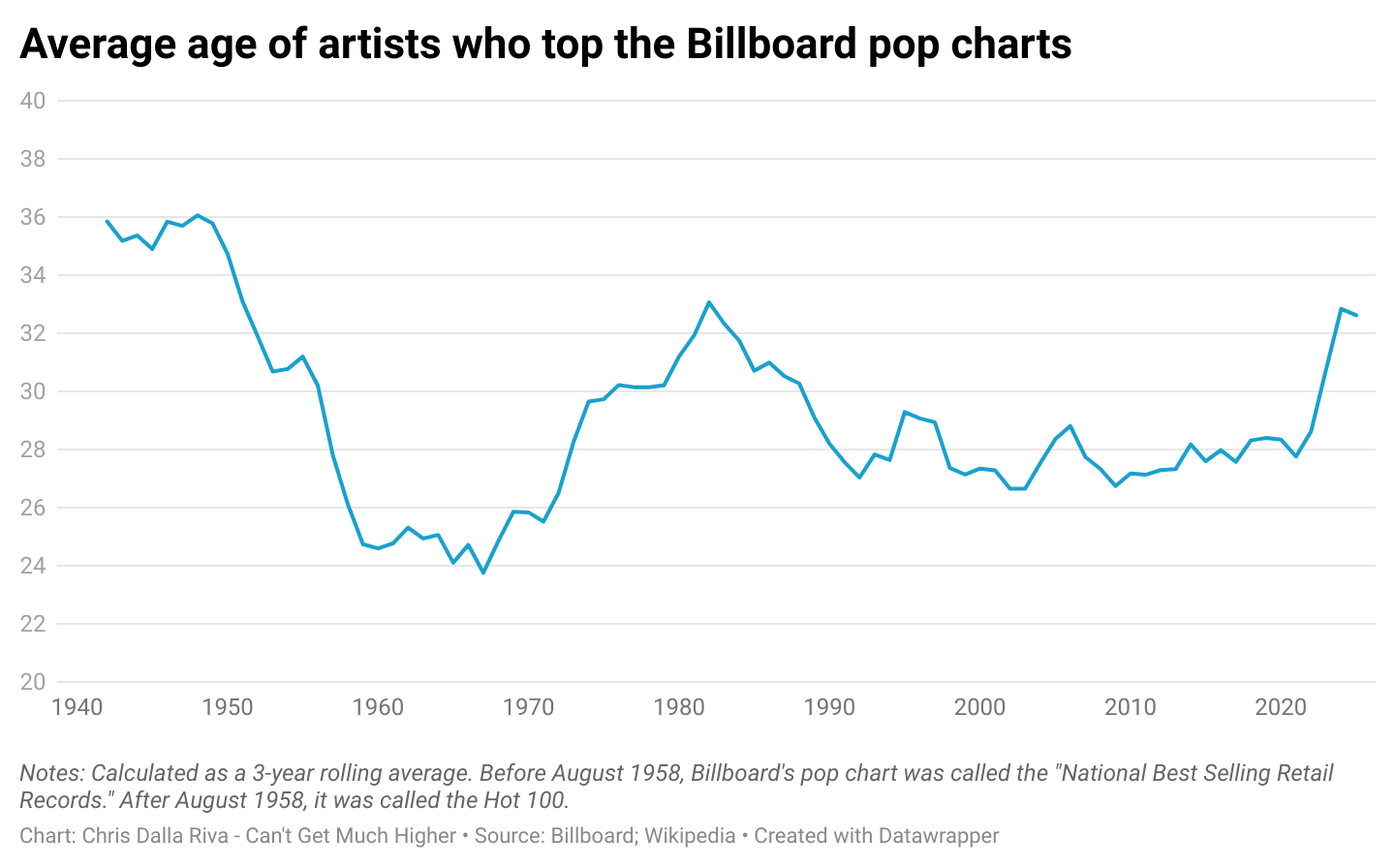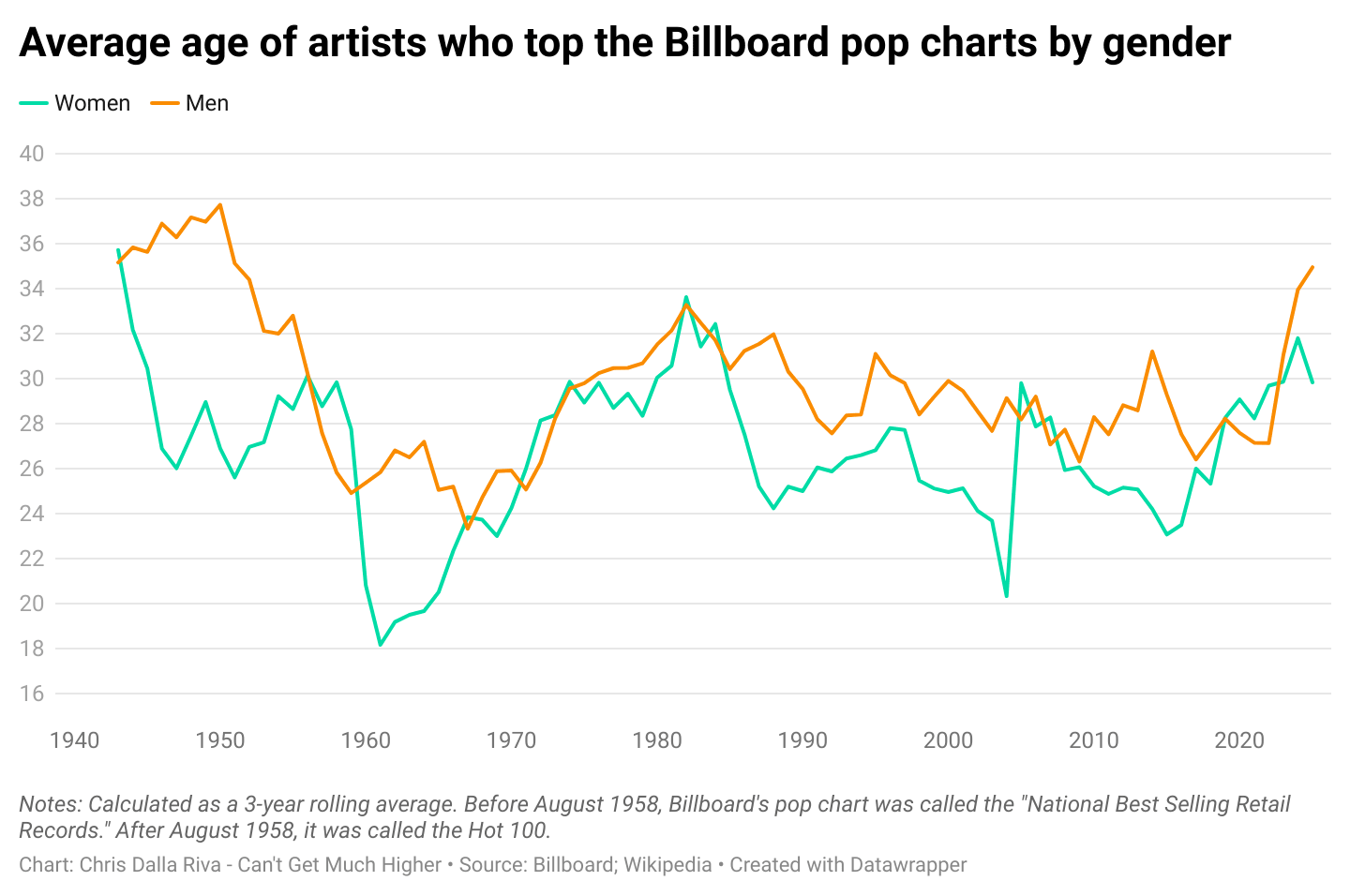Before we talk about the pop music gerontocracy, I wanted to remind you that my debut book Uncharted Territory: What Numbers Tell Us about the Biggest Hit Songs and Ourselves is coming out soon. It’s a data-driven history of popular music covering 1958 to 2025. If you’ve already purchased a copy, thank you so much! If you’re still not convinced, I hope the quality of this week’s piece changes your mind.
By Chris Dalla Riva
When Bruce Springsteen was signed to a Columbia Records in the early 1970s, he was among a small group of artists dubbed the “new Dylan.” Decades later, he joked about this nickname while giving the keynote address at South by Southwest:
I was signed as an acoustic singer/songwriter … by John Hammond at Columbia Records, along with Elliott Murphy, John Prine, [and] Loudin Wainwright III. We were all new Dylans. And the old Dylan was only 30. So, I don’t even know why they needed a fucking new Dylan, all right? But those were the times.
Dubbing all of these artists the “new Dylan” is especially funny when you realize at this point the real Dylan hadn’t even released Blood on the Tracks, what many people argue is his greatest record. Still, part of me understands why people were in search of a new Dylan. And it’s not because some people criticize his early 1970s work as inferior. It’s because most people make it on the pop music scene when they are quite young.
Before Paul McCartney turned 28, The Beatles had already broken up.
Before Stevie Wonder turned 27, he had released 18 albums, including the flawless foursome, Talking Book (1972), Innervisions (1973), Fulfillingness' First Finale (1974), and Songs in the Key of Life (1976).
Before Billie Eilish could legally drink alcohol, she had sold millions of records, topped the Billboard Hot 100, and won both an Oscar and a Grammy.
Even Bob Dylan illustrates this trend. By the time he was 26, he’d already redefined both rock and folk music by “going electric,” along with releasing seven records, at least five of which are considered classics. Though music is a lifelong pursuit, pop stardom is a young person’s game. But something weird has been going on recently.
Part of the reason that I wrote a data-driven history of popular music is because years ago I decided to listen to every song to ever top the Billboard Hot 100. While I was doing that, I tracked a ton of information about those songs, including each artist’s age when they topped the charts. In the grand scheme of things, pop stars are young. Between 1940 and 2025, the average age of a chart-topping artist never goes above 36. Still, there are some wild swings that deserve clarification.
From 1940 to 1950, pop stars were regularly in their mid-30s. Then they start to age backwards. By 1960, your average pop star is a decade younger than their counterparts in the 1940s. Why did this happen? One word: Teenagers.
Again, I discuss this in my book, but the idea that there was a distinct demographic group between childhood and adulthood is an invention of the 20th century. As this group became larger and more powerful, they began to differentiate their musical tastes from their parents and younger siblings. The music industry began to take note of this and promoted stars that were demographically closer to the teenagers that were buying records. This is part of the reason you end up from pop stars going from looking like Glenn Miller to Elvis Presley.
Throughout the 1960s, this model persisted. You had relatively young people making music marketed to relatively young people. This trend then reversed from around 1970 to 1982. During that period, your average pop star goes from 24 to 32.
I dedicate the first half of chapter four in my book to this topic, but much of it is related to the dissolution of musical groups at the end of the 1960s. You had members of The Beatles and The Supremes and The Temptations all pursuing solo careers at once, along with hit songwriters from the same decade, like Neil Diamond and John Denver. Naturally, these stars were older because they were effectively starting a second career.
But this trend was not to survive. The mid-30s pop star was to remain a relic of the 1940s. From 1990 to 2020, pop stars were regularly around 26 to 28, not as young as those in the 1960s but certainly not old. But then over the last 5 years, the “elderly” pop star has returned. As of the last three years, the average chart-topping artist was 33. Again, not old in the grand scheme of things but old in the world of pop music. What’s going on?
I first wanted to parse this trend out by gender. Maybe more men were topping the charts and those men were older. Part of this seems to be true. Men topping the charts are consistently older than women topping the charts, though the gap isn’t that large. With the 60% of number ones in the last three years coming from men, like Drake (38), Kendrick Lamar (36), Hozier (34), and Morgan Wallen (31), the average has been driven up. At the same time, gender doesn’t explain everything. Between 2010 and the most recent period, women pop stars have also aged four years on average.
My next thought was to explore if number one hits are more regularly by artists who have previously had number ones. Theoretically, those artists would be older. This partially seems to be the case too. In the most recent 3-year period, 59% of number one hits were by artists who had scored a number one before. Compare this to the period from 1963 to 1965 when only 37% of number ones were by artists who had topped the charts before. That said, this increase is not necessarily new. It’s been going on for the last few decades.
Even so, this increase isn’t enough to explain the current pop star gerontocracy. When you parse out the average age for first-time and repeat chart-topping artists, they actually follow each other pretty closely. In fact, from 1940 through today, these dual trends have an 87% correlation. What this means is that as repeat chart-toppers get older, so do the first-time chart-toppers.
In summary, though some of this trend is driven by the fact that there are more men topping the charts and men typically are older when they top the charts than women, the real story is that no matter how you slice this data, all cohorts of pop stars are getting older. Men are getting older. Women are getting older. People breaking into music are older. So are those that have already had hits.
This follows a trend that has been articulated elsewhere. Society is aging and the effects of that are being felt across all facets of life. As
aptly titled his recent Slow Boring piece, “Gerontocracy is everywhere.”
In one sense, I think it’s great we are seeing musicians continue to find success as they age. Nobody is saying that we need a new Taylor Swift because she turned 30 like they did when Bob Dylan turned 30. At the same time, we need labels to invest in the next generation of stars rather than purchasing catalogs of legacy acts. I don’t think pop culture is completely stagnant. There’s more music than ever before if you’re willing to go look for it. But if I turn on my local pop station in ten years and still hear the latest hit from Beyoncé, we might have a problem.
A New One
"undressed" by sombr
2025 - Indie Pop
Though I try to focus recommendations in this newsletter on things that are a bit more obscure, I figured this specific edition warrants the recommendation of a rising pop star. Following that train of thought, sombr fits the bill. The New Yorker is barely 20 and has found his way onto pop radio. While I didn’t love “we never dated,” his latest moody release, his previous single “undressed” is an earworm for days.
An Old One
"Hello, Dolly!" by Louis Armstrong
1964 - Music Hall
When I tell people that I listened to every Billboard Hot 100 number one in history, they always have two questions. First, how long did that take you? Answer: Because there have been over 1,100 number ones since the Hot 100 began in 1958 and I only listened to one song per day, it took close to three years.
Second, who is the oldest person to top the charts? Answer: Technically, it is Brenda Lee because her “Rockin’ Around the Christmas Tree” got to number one in December 2023 when she was 78. That said, the song came out in 1958. If you are looking for the oldest artist to top the charts that was actively releasing music during their chart run, then the answer is Louis Armstrong. The jazz legend topped the charts during the height of Beatlemania in May 1964 when he was 62.
If you enjoyed this piece, consider ordering my book Uncharted Territory: What Numbers Tell Us about the Biggest Hit Songs and Ourselves. The book chronicles how I listened to every number one hit in history and used what I learned during the journey to write a data-driven history of popular music from 1958 through today.
.png)









